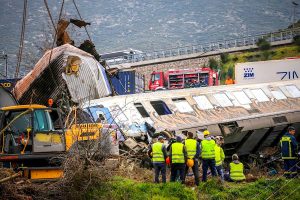The Athens Prosecutor’s Office has ordered an urgent investigation into another incident involving Greece’s train lines– this time a suburban train that almost entered the metro network in the Doukissis Plakentias area last week.
The new incident was revealed by the Athens daily “Efimerida ton Syntakton”, via access to a letter from the Panhellenic Union of Railway Staff addressed to the Railway Regulatory Authority and the National Accident Investigation Agency.
The letter alleges a suburban train received an order on Wednesday, October 9 at Doukissis Plakentias to enter the wrong line, namely a metro tunnel. The engine driver realized the mistake and tried, according to the report, to contact the stationmaster several times. The driver then reportedly decided to drive too slowly such that the train passed a sensor and was detected by the remote control system. At this point the Hellenic Railway Organization (OSE) controller responded and told him to reverse. The engine driver then had to drive in reverse for 300 meters.
The letter claims further that Suburban trains have a larger gauge and are not permitted to enter the underground network of the metro because they will get stuck.
“Hellenic Train announces that it is investigating the causes of the incident, which occurred on Wednesday 9 October, during which a Suburban train violated the entry signs on the Metro line at Doukissis Plakentias station,” wrote the Hellenic Train company on Thursday. “The investigation is being carried out in cooperation with the competent authorities, while the disciplinary procedure for accountability has been activated. The staff involved in the incident has been suspended.”
The Hellenic Railway Organization (OSE) also released a statement on Thursday, stating that “the train in question was running on a signaled (i.e. safe) route, which was not, however, accredited for its use as it is for Metro trains.” OSE placed blame on the suburban train driver, arguing he disregarded two light signals whose indications warned him of the train’s entry into the Metro lines, and that allegations about the incompatible gauges is exaggerated and the train could not get stuck in the tunnel. The railway organization also stated that the train was not on a collision track: “There was no opposing train movement, but possible movement of an unauthorized train on a metro line.”
This incident is the latest in a series of incidents on Greece’s rail lines, the most serious of which was the deadly head-on collision outside of Tempi which claimed 57 lives. However, in recent months there have been several other incidents including a near-collision on September 13 between two passenger trains near Aghii Anargyri station in northwest Athens. That potential disaster was narrowly avoided when train conductors, realizing they were on the same track, communicated and stopped the trains in time.
The Tempi tragedy exposed numerous problems plaguing Greece’s rail system, such as poorly trained staff, tracks in disrepair, a lack of fail-safe systems, malfunctioning radio communications, and chronic underfunding. Additionally, several parts of the Greek railways are still missing critical traffic control and signaling systems, which are required under European Union law, and were missing along the portion of the track where the Tempi crash occurred. While hundreds of millions of euros have been promised for upgrades– including improved signaling– reforms lag and problems persist.





